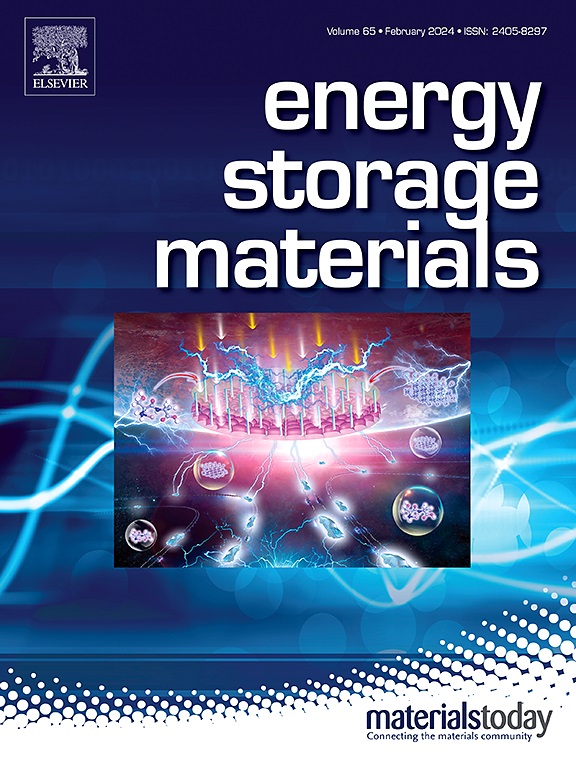释放全固态电池中富锂层状氧化物的潜力:挑战和策略
IF 20.2
1区 材料科学
Q1 CHEMISTRY, PHYSICAL
引用次数: 0
摘要
富锂阴极材料(LRCM)由于其独特的阴离子/阳离子协同氧化还原机制,成为下一代固态锂离子电池(sslib)的大容量阴极(>300 mAh/g)。然而,它们在液体电解质中的应用受到诸如不可逆容量损失、电压衰减和循环稳定性差等问题的阻碍。与固态电解质(ssi)的集成为克服这些限制提供了一条令人信服的途径,利用sslib固有的增强热稳定性、抑制过渡金属溶解和更宽的电化学稳定性窗口。这篇综述系统地研究了sslib中LRCM的演变,强调了它们在高压运行中的结构优势。至关重要的是,我们确定并分析了阻碍其性能的三个基本界面挑战:(1)缓慢的界面电荷转移动力学,(2)高压下有害的化学/电化学副反应,以及(3)氧气释放引起的机械降解。为了应对这些挑战,我们提供了最先进的改性策略的全面和关键概述,包括量身定制的材料成分设计,先进的界面工程和多尺度结构优化。此外,我们提出了前瞻性的协同设计范式,将机器学习加速的材料发现与先进的表征技术相结合,旨在阐明跨多个长度尺度的sslib中控制LRCM性能的关键结构-界面-属性关系。通过将基本的机理理解与实际工程考虑联系起来,本文综述为基于LRCM的高能量密度sslib的合理设计和开发提供了重要的见解和战略指导。本文章由计算机程序翻译,如有差异,请以英文原文为准。


Unlocking the potential of Lithium-rich layered oxides in all-solid-state batteries: Challenges and strategies
Lithium-rich cathode materials (LRCM) stand out as promising high-capacity cathodes (>300 mAh/g) for next-generation solid-state lithium-ion batteries (SSLIBs) owing to their unique anionic/cationic synergistic redox mechanisms. However, their deployment in liquid electrolytes is hampered by issues like irreversible capacity loss, voltage decay, and poor cycling stability. Integration with solid-state electrolytes (SSEs) offers a compelling pathway to overcome these limitations, capitalizing on the enhanced thermal stability, suppressed transition metal dissolution, and wider electrochemical stability window inherent to SSLIBs. This review systematically examines the evolution of LRCM within SSLIBs, emphasizing their structural advantages for high-voltage operation. Crucially, we identify and analyze three fundamental interfacial challenges impeding their performance: (1) sluggish interfacial charge transfer kinetics, (2) detrimental chemical/electrochemical side reactions at high voltages, and (3) mechanical degradation induced by oxygen release. To address these challenges, we provide a comprehensive and critical overview of state-of-the-art modification strategies, encompassing tailored material composition design, advanced interface engineering, and multiscale structural optimization. Furthermore, we propose forward-looking synergistic design paradigms that integrate machine learning-accelerated materials discovery with advanced characterization techniques, aiming to elucidate the critical structure-interface-property relationships governing LRCM performance in SSLIBs across multiple length scales. By bridging fundamental mechanistic understanding with practical engineering considerations, this review offers crucial insights and strategic guidance for the rational design and development of high-energy-density SSLIBs based on LRCM.
求助全文
通过发布文献求助,成功后即可免费获取论文全文。
去求助
来源期刊

Energy Storage Materials
Materials Science-General Materials Science
CiteScore
33.00
自引率
5.90%
发文量
652
审稿时长
27 days
期刊介绍:
Energy Storage Materials is a global interdisciplinary journal dedicated to sharing scientific and technological advancements in materials and devices for advanced energy storage and related energy conversion, such as in metal-O2 batteries. The journal features comprehensive research articles, including full papers and short communications, as well as authoritative feature articles and reviews by leading experts in the field.
Energy Storage Materials covers a wide range of topics, including the synthesis, fabrication, structure, properties, performance, and technological applications of energy storage materials. Additionally, the journal explores strategies, policies, and developments in the field of energy storage materials and devices for sustainable energy.
Published papers are selected based on their scientific and technological significance, their ability to provide valuable new knowledge, and their relevance to the international research community.
 求助内容:
求助内容: 应助结果提醒方式:
应助结果提醒方式:


